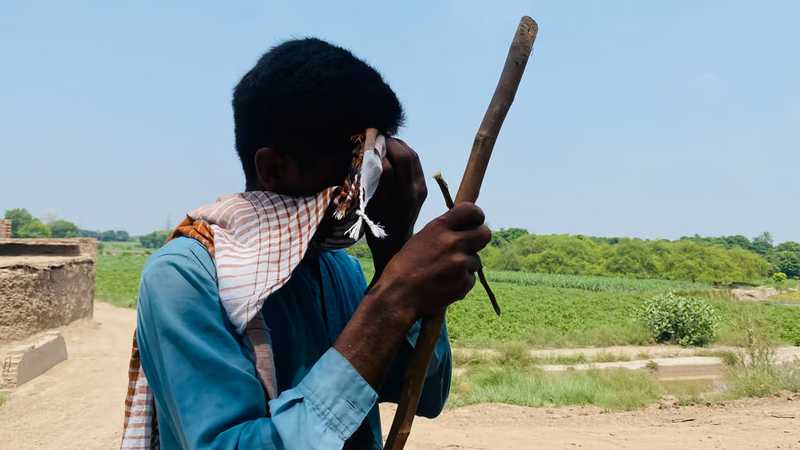
Editor’s Note: The following is a condensed version of the introduction to The Red Deal: Indigenous Action to Save Our Earth by The Red Nation. You can buy the full book, which comes out on April 20, here, and support the work of Red Media on Patreon here.
Colonialism has deprived Indigenous people, and all people who are affected by it, of the means to develop according to our needs, principles, and values. It begins with the land. We have been made “Indians” only because we have the most precious commodity to the settler states: land. Vigilante, cop, and soldier often stand between us, our connections to the land, and justice. “Land back” strikes fear in the heart of the settler. But as we show here, it’s the soundest environmental policy for a planet teetering on the brink of total ecological collapse. The path forward is simple: it’s decolonization or extinction. And that starts with land back.
In 2019, the mainstream environmental movement—largely dominated by middle- and upper-class liberals of the Global North— adopted as its symbolic leader a teenage Swedish girl who crossed the Atlantic in a boat to the Americas. But we have our own heroes. Water protectors at Standing Rock ushered in a new era of militant land defense. They are the bellwethers of our generation. The Year of the Water Protector, 2016, was also the hottest year on record and sparked a different kind of climate justice movement. Alexandria Ocasio-Cortez, herself a water protector, began her successful bid for Congress while in the prayer camps at Standing Rock. With Senator Ed Markey, she proposed a Green New Deal in 2019. Standing Rock, however, was part of a constellation of Indigenous-led uprisings across North America and the US-occupied Pacific: Dooda Desert Rock (2006), Unist’ot’en Camp (2010), Keystone XL (2011), Idle No More (2012), Trans Mountain (2013), Enbridge Line 3 (2014), Protect Mauna Kea (2014), Save Oak Flat (2015), Nihígaal Bee Iiná (2015), Bayou Bridge (2017), O’odham Anti-Border Collective (2019), Kumeyaay Defense Against the Wall (2020), and 1492 Land Back Lane (2020), among many more.
Each movement rises against colonial and corporate extractive projects. But what’s often downplayed is the revolutionary potency of what Indigenous resistance stands for: caretaking and creating just relations between human and other-than-human worlds on a planet thoroughly devastated by capitalism. The image of the water protector and the slogan “Water is Life!” are catalysts of this generation’s climate justice movement. Both are political positions grounded in decolonization—a project that isn’t exclusively about the Indigenous. Anyone who walked through the gates of prayer camps at Standing Rock, regardless of whether they were Indigenous or not, became a water protector. Each carried the embers of that revolutionary potential back to their home communities. Water protectors were on the frontlines of distributing mutual aid to communities in need throughout the pandemic. Water protectors were in the streets of Seattle, Portland, Minneapolis, Albuquerque, and many other cities in the summer of 2020 as police stations burned and monuments to genocide collapsed. The state responds to water protectors—those who care for and defend life—with an endless barrage of batons, felonies, shackles, and chemical weapons. If they weren’t before, our eyes are now open: the police and the military, driven by settler and imperialist rage, are holding back the climate justice movement.
The Red Deal
The Green New Deal (GND), which looks and sounds like ecosocialism, offers a real chance at galvanizing popular support for both. While anticapitalist in spirit and paying lip service to decolonization, it must go further—and so too must the movements that support it.
That’s why The Red Nation initiated the Red Deal in 2019, focusing on Indigenous treaty rights, land restoration, sovereignty, self-determination, decolonization, and liberation. We don’t envision it as a counterprogram to the GND, but rather going beyond it. It is “red” because it prioritizes Indigenous liberation and a revolutionary left position. As we show in the following pages, this platform isn’t just for Indigenous people.
The GND has the potential to connect every social justice struggle—free housing, free health care, free education, green jobs—to climate change. Likewise, the Red Deal places anticapitalism and decolonization as central to each social justice struggle, as well as climate change. The necessity of such a program is grounded in both the history and future of this land, and it entails the radical transformation of all social relations between humans and the Earth.
What follows is a plan of collective climate action based on four principles that we developed after extensive conversation, dialogue, and feedback from Indigenous and non-Indigenous community members, comrades, relatives, and fellow travelers:
- What Creates Crisis Cannot Solve It
Divestment was a popular strategy during the #NoDAPL uprising in 2016. Water protectors called upon the masses to divest from the financial institutions subsidizing the pipeline. The Red Deal continues this call for divestment from fossil fuel industries, but we go one step further. We draw from Black abolitionist traditions to call for divestment from carceral institutions like police, prisons, the military, and border imperialism in addition to divestment from fossil fuels.
- Change from Below and to the Left
It is important to remember that the GND was possible only because its main proponent, Alexandria Ocasio-Cortez, became politicized by the #NoDAPL uprising. Indigenous people are, and have always been, at the forefront of the struggle for climate justice. We will not back down from the GND’s demands for a dignified life, nor will we back down from centering the leadership of Indigenous people in this fight. In fact, we must go further. We must throw the full weight of people power behind these demands for a dignified life. People power is the organized force of the masses—a movement to reclaim our humanity and rightful relations with the Earth. People power will not only topple empire, but it will build a new world from the ashes; a world where many worlds fit.
- Politicians Can’t Do What Only Mass Movements Do
States protect capital and its caretakers: the ruling class. They do not protect the people. Reformists who appeal to the state for change compromise our future by aligning with the interests of the ruling class. We refuse to compromise. But we do believe in reform—just a different kind, a non-reformist reform that doesn’t limit the possibility of what the status quo offers, but which fundamentally challenges the existing structure of power by prioritizing, organizing, and elevating the needs and demands of the masses.
We don’t want to improve the system by implementing policies from the top down, we want to destroy it—either by fire or a million small cuts—in order to replace it. Our philosophy of reform is thus to reallocate social wealth back to those who actually produce it: workers, the poor, Indigenous peoples, women, migrants, caretakers of the land, and the land itself. The restoration of social wealth means the empowerment of those who have been dispossessed. Social wealth can be restored by building a mass movement that has the power and leverage to reclaim resources from the ruling class and redistribute them to the dispossessed.
- From Theory to Action
From the White House to CEOs of multinational corporations, bosses run the world and plunder without challenge. Given the staggering amount of destruction and death just a few individuals inflict on billions, it is strange that no unified left has emerged in the Global North to pose a real threat to the bosses. We have witnessed in the last handful of years massive grassroots rebellions against the fossil fuel industry, police violence, racist immigration policies, and labor exploitation, yet nothing has coalesced into a unified mass movement. We believe that struggling for non-reformist reforms to restore the health of our bodies and the Earth will serve as the most powerful vehicle for building a mass movement—fast—that can take on the bosses. But we cannot simply be against something—we must be for something.
We will construct our own policies out of grassroots action that seeks to caretake and support one another. Through organizing around non-reformist reforms for housing, food security and sovereignty, domestic and gender violence justice, suicide prevention, land restoration, and more, we can and will build infrastructures of liberation. As the Black Panther Party decided at a certain juncture in its history, The Red Nation realizes we must undertake realistic and principled actions now that will help build our cumulative capacity for revolution in the future. We must not turn away from the truth: we do not yet possess the capacity for revolution, otherwise we would have seen a unified mass movement come out of the remarkable revolutionary energy of the past decade. And yet, we have very little time to get there. This is the contradiction and the duty of our generation: decolonization or extinction.
Liberation isn’t a theory, it’s a necessity and a right that belongs to the humble people of the Earth. How will we make it happen? We will not turn away from opportunities to organize, agitate, and build people power in spaces of state surveillance like prisons, child services, hospitals, and classrooms that are designed to dehumanize and disempower the people. The state sets its targets on poor and working-class people because it knows they pose the greatest threat to its existence. We will not let the state steal our relatives or gut our power any longer. We must swarm the state, inside and out, multiplying the threat by millions until it crumbles.
Our non-reformist reforms will come in many forms. They will look like grassroots Indigenous seed bank networks where thousands of sustainable farmers share, trade, and feed their communities. They will look like successful runs for city council elections where left candidates implement a people’s platform for climate and social justice at city and municipal levels. They will look like land back camps or tribal council resolutions that reject colonial water settlements by banding with other Indigenous nations to blockade all government and corporate efforts to commodify water. Whatever form they take, we must simply get to work.
Buy The Red Deal: Indigenous Action to Save Our Earth here, and support the work of Red Media on Patreon here.



